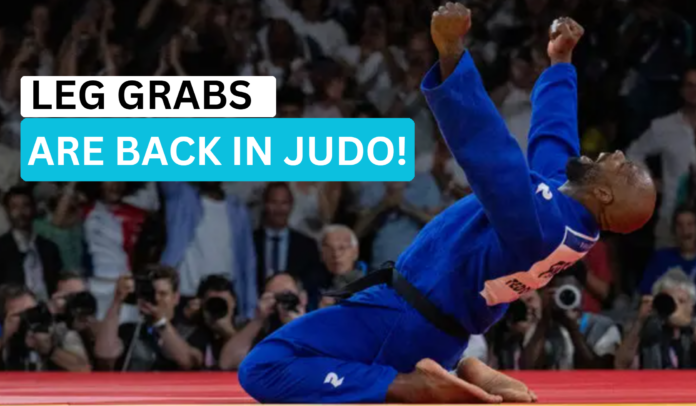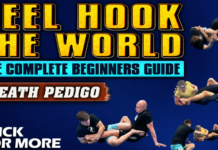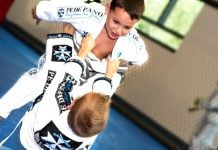
The latest information coming by way of the reputable L’ Esprit du Judo magazine is that Kodokan decided to reinstate Judo leg grabs as legal techniques once again. The changes are set to come into effect as early as April 2025, with the new ruleset premiering at the All Japan Judo Championships in Japan.
Whether the changes will remain limited to Judo matches under the All Japan Judo Federation (AJF) that governs Judo in Japan or the IJF (International Judo Federation) is going to jump on board and accept the change Judokas have been aching for is still not clear at the moment.
That said, the return of leg grabs, or Ashitori in Judo is not as straightforward as it seems, as lifting the judo leg grab ban comes with specific conditions and some lingering limitations.
What is the Judo Leg Grab Ban?
The Judo leg grab ban is an aspect of sports Judo that has been pissing off grapplers for the better part of four decades, including me. Judo was the very first martial art that I started over 30 years ago, but once I discovered wrestling and BJJ, many of the Judo rules didn’t make any sense.
One such rule was the outlawing of leg grabs, which prohibited grabbing the opponent’s pants at any point. The goal of this restriction was to emphasize upper-body throws, only allowing leg-on-leg contact for sweeps.
While this Judo leg grab ban evolved throughout the years, the most important aspect was that it resulted in immediate disqualification, which took away a lot from the noble sport of Judo.
Why Did Judo Get Rid of Leg Grabs?
Initially, someone in the IOC (International Olympic Committee) decided that Judo and wrestling were too much alike and that people needed a clear distinction in order for both combat sports to feature in the Olympics. The main argument back then was that removing leg grabs reinforced the traditional upright posture that is symbolic of Judo.
Instead of mitigations of this rule, the years that followed brought even further restrictions, claiming that these helped force athletes to be more engaged and stall less, as leg grabs offered a way to force counterattacking play only and resulted in less attractive matches.
At the end of the day, removing leg grabs had nothing to do in reality with distinguishing Judo from wrestling, or the safety of competing athletes, and was simply geared towards aesthetics, rather than effectiveness.
When Did Judo Ban Leg Grabs?
The timeline of the Judo leg grabs ban dates back more than 40 years, and features a couple of important evolutions that increased the limitations:
- 1980s – The initial ban started, for the purposes of encouraging action and making Judo distinct from wrestling. As if wearing the Gi was not distinctive enough.
- 2010 Thw IJF decided that the ban on judo leg grabs was not precise enough, and took it further, prohibiting athletes from grabbing the trousers of their opponents during standing exchanges.
- 2013 – The year when the Judo leg grabs nonsense reached its pinnacle, with the IJF stating that any grip anywhere along the material of the trousers is illegal during any interaction of the Judokas.
From 2013, grappling athletes, including MMA fighters, BJJ athletes, and wrestlers were all adamant about supporting Judokas in asking for a change to a rule that never really made any sense, and is effectively maiming Judo athletes in the world of competitive grappling and combat sports.
Which Judo Leg Grab Techniques Are Back?
Now that the origins and evolution of the Judo leg grab ban are clear, let’s see what the future brings and what Judo with leg grabs is going to look like.
The AJF’s change to the rule of leg grabs refers to both attacking and defending athletes. In other words, Judokas can now reach for the legs directly while attacking and/or defending, which was illegal until October 2024.
This inevitably raised the question of which Judo leg grab techniques are now back as legal, and if you can do whatever you want to the legs. As much as we’d love to see Russian Judo moves introduced to modern Judo, there are two key conditions to this new rule change:
- There must be an upper body grip. When the Judo competitors are engaged in Kumikata, they can go for leg grabs. If neither of the athletes has a grip on the upper body, grabbing the legs is still a foul. For the sake of clarity, shooting for a double or single leg is still not allowed.
- Only one arm can grip a leg. Further narrowing the scope of the judo leg grab techniques at Judoka’s disposal, the rule change states that only one-arm grabs are allowed, meaning moves like the Morote Gari a.k.a. double leg takedown are still out of the question, even if the athletes are previously engaged in Kumikata.
While still limiting, this does open the door for some Judo classics that we’ve not seen since 2013, such as Kata Guruma, Te Guruma, and various ankle picks that are very common in Russian and Mongolian Judo.
Is Judo Better Without Leg Grabs?
This remains to be seen, with lots of eyes on the upcoming All Japan Judo Championship in April 2025. However, there are a few talking points that offer both advantages and disadvantages of re-introducing leg grabs to Judo after such a long hiatus.
There is merit to the notion that Judo matches that allow direct leg grabs can turn into snooze-fest of stalling. Just take a look at the 2008 Olympics match between Naidan and Suzuki and you’ll understand exactly what I mean.
Along the same lines, the introduction of leg grabs will force Judokas into a starting posture that resembles the hunched one we see in BJJ and wrestling, which will make some of the big and most attractive throws almost impossible to set up at the highest levels.
That said, the new rules go a long way towards mitigating passive behavior by limiting shooting, effectively sticking to the Judo principles that we know – grip fighting from an upright position until engagement.
Another big positive is the return of some signature throws, trips, and traditional Judo combinations that we’ve not seen at the highest levels for over a decade. It will also provide much more entertaining matches when two Judokas with a significant height difference face off on the mats.
A final technical advantage of the new 2024 Judo leg grab rule is that defending moves such as the Osoto Gari are going to become much more versatile, opening a new dimension to counterattacking Judo and improving the effectiveness of outside and inside sweeps in the process.
IJF vs Japan?
As I conclude this article I’ll address the burning question: When, will the IJF adopt the new ruleset and make it international? Or, perhaps the question to as is Whether the IJF is going to consider such action at all.
One thing is for certain – the 2025 All Japan Judo Championship is going to change Judo forever, whether the rules on Judo leg grabs remain limited to Japan only, or spread around the world. If the latter happens, we’ll see a revolution in sports Judo as people scramble to re-learn moves that have been missing from competitive Judo for more than 40 years.
At this point, there is still no official comment from the IJF on the lifting of the Judo leg grab ban by the AJF. Let’s wait and see what April 2025 brings.
Japanese Judo Grip Fighting Secrets Satoshi Ishii DVD Review


![Darce Choke Encyclopedia – Origins, Mechanics and Variations [2025] BJJ, choke, Brabo, BJJ Darce Choke, D'arce Choke, Darce BJJ Choke](https://bjj-world.com/wp-content/uploads/2017/11/JungPoirierLeeYahoo-218x150.jpg)













![[VIDEO] Ex-UFC Champ Aljamain Sterling Gets Choked Out Cold on Russian TUF-Style Show VIDEO - Aljamain Sterling Gets Choked Out Cold on Russian Reality Show](https://bjj-world.com/wp-content/uploads/2025/04/LEG-GRABS-2-218x150.png)


![Slicin’ Calves Mikey Musumeci DVD Review [2025] Slicin' Calves Mikey Musumeci DVD Review](https://bjj-world.com/wp-content/uploads/2025/04/slicin-calves-mikey-musumeci-dvd-review-218x150.png)
![Jiu-Jitsu For Old Guys Guard Retention Bernardo Faria DVD Review [2025] Jiu-Jitsu For Old Guys Guard Retention Bernardo Faria DVD Review](https://bjj-world.com/wp-content/uploads/2025/03/old-guys-guard-retention-bernardo-faria-dvd-review-218x150.png)
![Power Passing Body Locks Dan Manasoiu DVD Review [2025] Power Passing Body Locks Dan Manasoiu DVD Review](https://bjj-world.com/wp-content/uploads/2025/01/power-passing-body-locks-dan-manasoiu-dvd-review-324x235.png)

![Countering with Crab Ride Anthony Budion DVD Review [2025] Countering with Crab Ride Anthony Budion DVD Review](https://bjj-world.com/wp-content/uploads/2025/03/countering-with-crab-ride-anthony-budion-dvd-review-100x70.png)



![Two Sides One Game Sweep and Pass Marcos Tinoco DVD Review [2024] Two Sides One Game Sweep and Pass Marcos Tinoco DVD Review](https://bjj-world.com/wp-content/uploads/2024/11/sweep-and-pass-marcos-tinoco-dvd-review-100x70.png)
![Breaking Their Guard Mikey Musumeci DVD Review [2025] Breaking Their Guard Mikey Musumeci DVD Review](https://bjj-world.com/wp-content/uploads/2025/02/breaking-their-guard-mikey-musumeci-dvd-review-100x70.png)
![Bricks Kesa Gatame System Jeremy Brick DVD Review [2025] Bricks Kesa Gatame System Jeremy Brick DVD Review](https://bjj-world.com/wp-content/uploads/2025/02/bricks-kesa-gatame-system-jeremy-brick-dvd-review-100x70.png)


![How To Knee Cut Junny Ocasio BJJ DVD Review [2025] How To Knee Cut Junny Ocasio BJJ DVD Review](https://bjj-world.com/wp-content/uploads/2025/02/how-to-knee-cut-junny-ocasio-bjj-dvd-review-100x70.png)
![Darces From Everywhere Kade and Tye Ruotolo DVD Review [2024] Darces From Everywhere Kade and Tye Ruotolo DVD Review](https://bjj-world.com/wp-content/uploads/2024/10/darces-from-everywhere-kade-and-tye-ruotolo-dvd-cover-100x70.png)
![Complete Front Headlock System Michael Pixley DVD Review [2024] Complete Front Headlock System Michael Pixley DVD Review](https://bjj-world.com/wp-content/uploads/2024/10/front-headlock-system-michael-pixley-dvd-review-100x70.png)
![Feet Finder Foot Sweeps Christian Ozbek DVD Review [2024] Feet Finder Foot Sweeps Christian Ozbek DVD Review](https://bjj-world.com/wp-content/uploads/2024/09/feet-finder-foot-sweeps-christian-ozbek-dvd-review-100x70.png)
![Full Guard Formula James Booth DVD Review [2025] Full Guard Formula James Booth DVD Review](https://bjj-world.com/wp-content/uploads/2025/02/full-guard-formula-james-booth-dvd-review-100x70.png)
![The Rack Kyle Watson BJJ DVD Review [2025] The Rack Kyle Watson BJJ DVD Review](https://bjj-world.com/wp-content/uploads/2024/12/the-rack-kyle-watson-bjj-dvd-review-100x70.png)
![Intro To Hip Mobility for Guard Players Joshua Presley DVD Review [2024] Intro To Hip Mobility for Guard Players Joshua Presley DVD Review](https://bjj-world.com/wp-content/uploads/2024/09/hip-mobility-for-guard-joshua-presley-dvd-review-100x70.png)

![Arm Bar It All Shawn Melanson DVD Review [2025] Arm Bar It All Shawn Melanson DVD Review](https://bjj-world.com/wp-content/uploads/2025/03/arm-bar-it-all-shawn-melanson-dvd-review-100x70.png)



![The Bear Trap Nicolas Renier DVD Review [2025] The Bear Trap Nicolas Renier DVD Review](https://bjj-world.com/wp-content/uploads/2025/01/the-bear-trap-nicolas-renier-dvd-review-100x70.png)
![Forging The De La Riva Guard Giancarlo Bodoni DVD Review [2025]](https://bjj-world.com/wp-content/uploads/2025/02/de-la-riva-guard-giancarlo-bodoni-dvd-review-100x70.png)
![Collar Sleeve Guard Mikey Musumeci DVD Review [2024] Collar Sleeve Guard Mikey Musumeci DVD Review](https://bjj-world.com/wp-content/uploads/2024/12/collar-sleeve-guard-mikey-musumeci-dvd-review-100x70.png)
![Essential Shin To Shin System Shawn Williams DVD Review [2025] Essential Shin To Shin System Shawn Williams DVD Review](https://bjj-world.com/wp-content/uploads/2025/01/shin-to-shin-system-shawn-williams-dvd-review-100x70.png)
